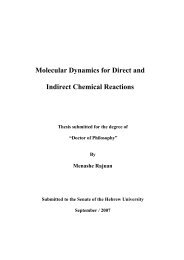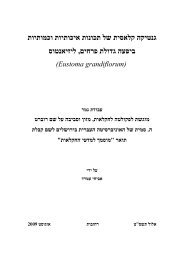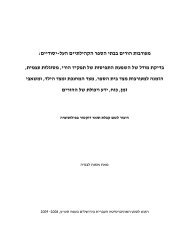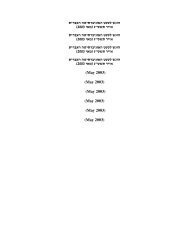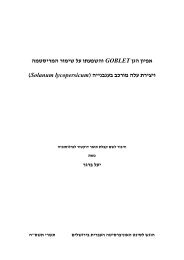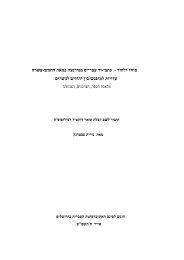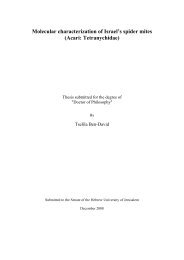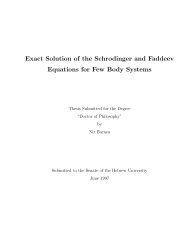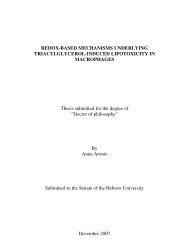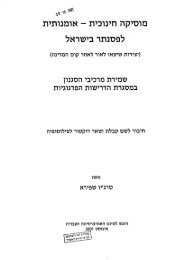Revealing the Mechanism of HSP104 Transcription Initiation in the ...
Revealing the Mechanism of HSP104 Transcription Initiation in the ...
Revealing the Mechanism of HSP104 Transcription Initiation in the ...
You also want an ePaper? Increase the reach of your titles
YUMPU automatically turns print PDFs into web optimized ePapers that Google loves.
Hsf1 constitutively b<strong>in</strong>ds <strong>the</strong> <strong>HSP104</strong> promoter<br />
Our previous promoter analysis and genetic studies revealed that <strong>HSP104</strong><br />
transcriptional <strong>in</strong>duction is mediated by some cooperation between Hsf1 and Msn2/4<br />
[(47); see also Figs. 2 and 3]. The dynamics <strong>of</strong> promoter occupancy by each <strong>of</strong> <strong>the</strong>se<br />
activators and <strong>the</strong> mutual relationship between <strong>the</strong>m are not known. To reveal <strong>the</strong><br />
dynamics <strong>of</strong> promoter occupancy by Hsf1, we employed ChIP assays <strong>in</strong> wild type and<br />
various mutant stra<strong>in</strong>s grown under optimal growth conditions and <strong>in</strong> response to heat<br />
shock. We found that Hsf1 b<strong>in</strong>d<strong>in</strong>g is constitutive under all conditions tested <strong>in</strong> wild<br />
type cells and <strong>in</strong> <strong>the</strong> msn2∆msn4∆, ras2∆ and ras2∆msn2∆msn4∆ stra<strong>in</strong>s (Fig. 13A).<br />
Notably, basal b<strong>in</strong>d<strong>in</strong>g <strong>of</strong> Hsf1 to <strong>the</strong> <strong>HSP104</strong> promoter <strong>in</strong> ras2∆ cells is reduced<br />
compared to its b<strong>in</strong>d<strong>in</strong>g <strong>in</strong> o<strong>the</strong>r stra<strong>in</strong>s (Figs. 13A and B). In order to rule out <strong>the</strong><br />
possibility that lower b<strong>in</strong>d<strong>in</strong>g <strong>of</strong> Hsf1 <strong>in</strong> ras2∆ cells reflects lower steady state levels<br />
<strong>of</strong> Hsf1 <strong>in</strong> <strong>the</strong>se cells, we performed western blot analysis and observed that steady<br />
state levels <strong>of</strong> Hsf1 are <strong>in</strong> fact identical <strong>in</strong> all stra<strong>in</strong>s and are not affected by heat<br />
shock (Fig. 13C). The lower Hsf1 promoter occupancy <strong>in</strong> ras2∆ cells may be<br />
<strong>in</strong>terpreted as if <strong>the</strong> Ras cascade positively regulates Hsf1's DNA b<strong>in</strong>d<strong>in</strong>g ability. We<br />
believe, however, that <strong>the</strong> weaker Hsf1 b<strong>in</strong>d<strong>in</strong>g <strong>in</strong> ras2∆ cells is a result <strong>of</strong><br />
constitutive b<strong>in</strong>d<strong>in</strong>g <strong>of</strong> Msn2/4 to <strong>the</strong> promoter <strong>in</strong> this stra<strong>in</strong> [(47); and Fig. 4) that<br />
partially disturbs Hsf1’s b<strong>in</strong>d<strong>in</strong>g. Indeed, removal <strong>of</strong> Msn2/4 from ras2∆ cells<br />
(ras2∆msn2∆msn4∆) results <strong>in</strong> resumption <strong>of</strong> efficient b<strong>in</strong>d<strong>in</strong>g <strong>of</strong> Hsf1 to <strong>the</strong><br />
promoter (Fig. 13A and B). Also, as shown above <strong>in</strong> ras2∆ cells, Hsf1 is dispensable<br />
for <strong>HSP104</strong> promoter activity as <strong>in</strong> <strong>the</strong>se cells promoter activity was constitutively<br />
high even after all HSEs were deleted [(47); and Fig. 4].<br />
34



